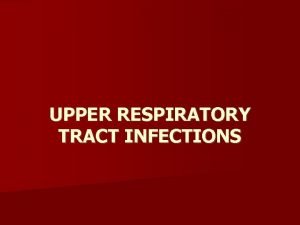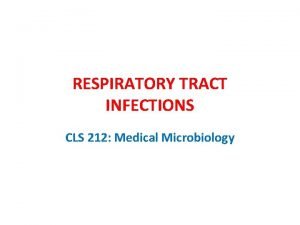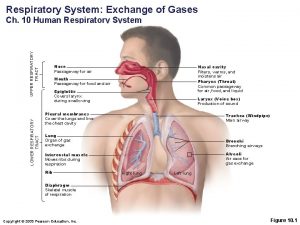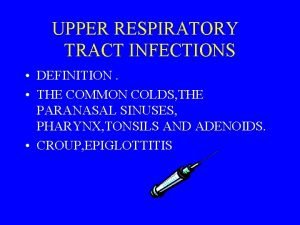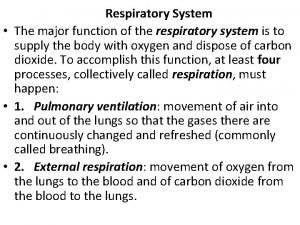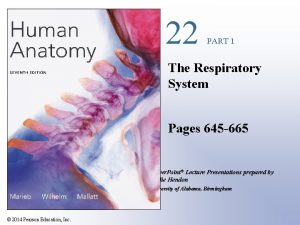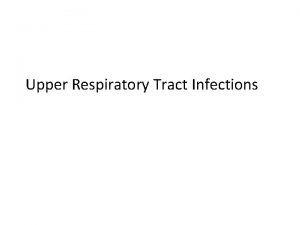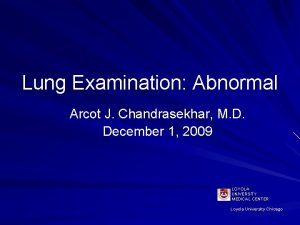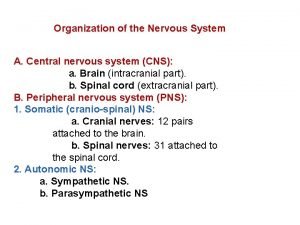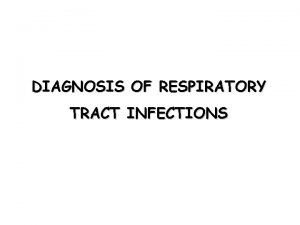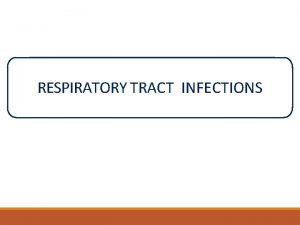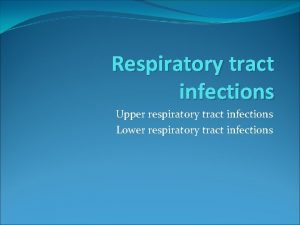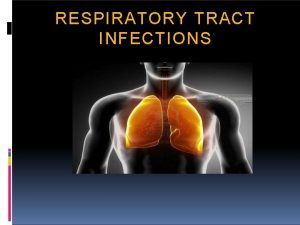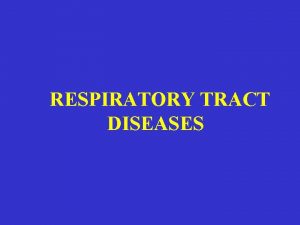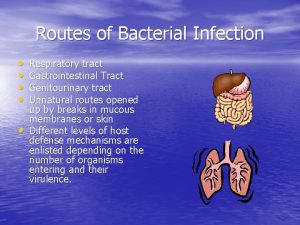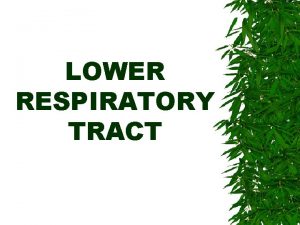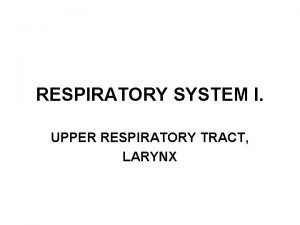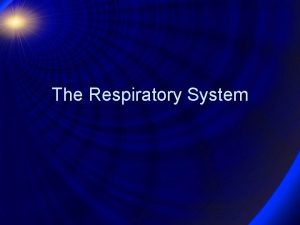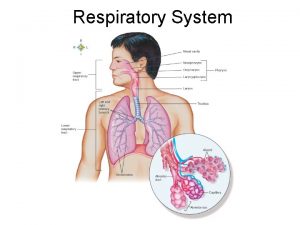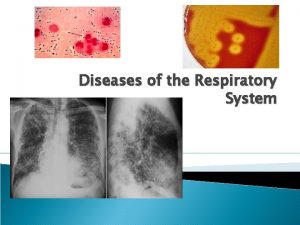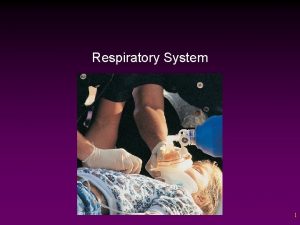Respiratory System u Disease of the respiratory tract































- Slides: 31

Respiratory System

u Disease of the respiratory tract is a major problem for cattle, sheep and goats and it continues to cause serious economic losses for producers. Bovine respiratory disease (BRD) causes increased death losses as well as medication costs, labor, and lost production

DISEASE CONDITIONS (OR SYNDROMES) u 1. Upper respiratory tract infections These infections cause inflammation of the nostrils, throat (pharynx) and windpipe (trachea). The clinical signs are usually mild and involve coughing, nasal discharge, fever, and a decreased appetite.

2. Diphtheria This infection involves the larynx (voice box) and may occur alone or along with other respiratory infections. There are often loud noises during breathing and the swelling may severely restrict the air flow and result in death of the animal.

3. Pneumonia (lower respiratory tract infection) u u u An infection of the lungs is often due to an extension of infection from the upper respiratory tract (#1) or a failure of the mechanisms which are designed to protect the lungs. It is much more serious and causes more severe signs than does an upper respiratory infection. Shipping fever is one form of lower respiratory tract disease and derives its name from the usual occurrence of the disease shortly after shipment of the cattle.

CAUSES AND DEVELOPMENT OF DISEASE u The causes of BRD are multiple and complex, but the three factors of stress, viral infection and bacterial infection are almost always involved in cases of severe disease. u A wide variety of different stressors and agents may be involved in the disease process.

Stress factors Viral Agents Bacterials Heat Cold Dust Dampness Injury Fatigue Dehydration Hunger Anxiety Irritant gases Nutritional def. Surgery PI 3 IBR BVD BRSV Adenovirus Rhinovirus Herpesvirus Enterovirus Reovirus Pasteurella Hemophilus Other

CLINICAL SIGNS u The most common signs of BRD are nasal and eye discharges, coughing, fever, decreased appetite, varying degrees of breathing difficulty and noise, rapid breathing, depression, droopy ears, open mouthed breathing and death. These vary greatly, depending on the stage and extent of the disease process.

Treatment u u The antibiotics and sulfas have no effect on the viral agents but are often of great aid against the bacterial invaders. Treatment of BRD will be effective and the death loss minimal if the following principles are practiced: 1) early disease detection so those ill can be treated and separated to a sick pen. 2) prompt initiation of an effective treatment program and continuation on a daily basis. 3) continue treatment until 48 hours after signs have abated 4) change to an alternate treatment if there is no or poor response after 24– 48 hours. 5) good nursing care including cautious handling of both the ill and exposed cattle.

PREVENTION OF BRD u The two major areas to emphasize for prevention are management and vaccination. Of the two, management is usually much more important.

IBR (Infectious Bovine Rhinotracheitis— Rednose) Herpes virus u A viral infection of the upper respiratory tract. It is present in almost all herds, but causes illness in unexposed animals or those with lowered levels of immunity. Many cattle carry the virus and begin shedding it to others during times of stress. This agent is commonly implicated with bacterial agents in causing shipping fever and other severe cases of pneumonia.

Clinical signs u u include high fever, anorexia, coughing, excessive salivation, nasal discharge that progresses from serous to mucopurulent, conjunctivitis with lacrimal discharge, inflamed nares (hence the common name “red nose”), and dyspnea if the larynx becomes occluded with purulent material. Nasal lesions consist of numerous clusters of grayish necrotic foci on the mucous membrane of the septal mucosa, just visible inside the external nares.

Diagnosis u Samples should be taken early in the disease, and a diagnosis should be possible in 2 -3 days. A rise in serum antibody titer also can be used to confirm a diagnosis

Treatment and Control u u Antimicrobial therapy is indicated to prevent or treat secondary bacterial pneumonia. Vaccines; Both MLV (modified live virus) vaccines and killed (or attenuated) products are available. Some are designed for IM (intramuscular) use while others are given IN (intranasally). The killed and intranasal products may be used for, or around, pregnant cows but some other vaccines may cause abortions. The IN vaccines will cause some antibody response within 3 days and may be useful even in the face of an outbreak. Two doses of a killed product must be used to confer protective immunity

PI 3 (Parainfluenza-3): u Another viral respiratory agent that causes a relatively mild disease by itself, but a severe problem when combined with a bacterial agent. u Bovine parainfluenza type-3 (PI 3) is a member of the Paramyxovirus (influenza-like) family, which is antigenically and biologically distinct from true influenza viruses.

Parinfluenza virus PI 3 Clinical Signs

Bovine Respiratory Syncytial Virus (BRSV) u. A relatively recently recognized disease agent, but now identified all across the country in respiratory infections. It is mainly a problem in weaner and feedlot animals (also young dairy stock) u Respiratory syncytial viruses are also members of the Paramyxovirus family.

Clinical Signs u Outbreaks of rapidly spreading, usually mild respiratory disease are commonly associated with BRSV has a sudden onset, and most cattle will exhibit increased respiratory rates, watery nasal and ocular discharge, cough, and decreased milk production. The course varies from three to 10 days. Some cases will show signs of depression and have excess salivation, which may be foamy or blood-tinged. Pneumonia occurs in a very small percentage of cases. Fatalities are rare, but can occur within two days of onset

Clinical signs: Bovine Respiratory Syncytial Virus (BRSV) affects the respiratory tract.

Prevention u Killed virus vaccines are available with two initial doses required. Modified live virus vaccines are also available.

Bovine Viral Diarrhea (BVDV) u Bovine Viral Diarrhea (BVDV) is caused by an RNA virus classified as a Flavivirus. This virus, which is easily transmitted and prevalent throughout the world u It is most common in young cattle (6 -24 mo old)

Clinical Signs u A variety of clinical disease patterns are attributed directly or indirectly to BVDV. These disease patterns are generally separated into three clinical forms, which may all occur in the same herd or appear separately: acute, chronic, and mucosal disease.

Clinical Signs

Treatment u Like most viral diseases, there is no treatment for BVDV. Some sources advocate vaccination with a MLV vaccine in the face of a disease outbreak. However, the value of this method is not well recognized.

Prevention and Control Vaccination of the whole herd, detection and culling of PI animals, and production and transfer of good quality colostrum to newborn calves is the first line of defense against BVDV Types I and II. u A well vaccinated cow will transfer temporary passive immunity to the calf through her colostrum. This protection usually lasts four-six months. u All calves should be vaccinated at around six months of age and receive regular boosters thereafter. u

Mannheimia u u The pneumonic form of pasteurellosis (Mannheimia) in cattle is usually associated with infection by Mannheimia haemolytica and less often with Pasteurella multocida. Mannheimia is common among beef calves after weaning in the fall and is the most important disease in feedlot cattle. Morbidity may reach 35%, and the mortality may vary from 1% to 10%. In addition to death losses, there is a serious loss of production in both beef and dairy cattle

Clinical Signs u u u Disease outbreaks commonly occur 10 -14 days after cattle have been transported and delivered to the feedlot. Pasteurella is a major contributor to "shipping fever" or bovine respiratory disease complex, an ever-present threat in cattle that have been transported. Mannheimia usually develops in cattle within 10 -14 days after they have been stressed. The first sign of an outbreak may be sudden deaths without previous warning. Affected cattle are depressed and do not eat (but will drink). They will have rapid, shallow respiration with a low productive cough that becomes pronounced if they are forced to walk. Affected cattle will generally have a cloudy nasal discharge, a crusty nose (the "snots"), and an ocular discharge. Close examination will reveal a fever and evidence of pneumonia


Treatment u Unlike viral infection, pasteurella can be effectively treated with antibiotics. Many affected cattle recover within two hours, if treated early. In feedlot situations where large numbers of cattle may be involved, treatment may be needed for three to five days

Control and Prevention: u Prevention of shipping fever pneumonia should focus on reduction of the stressors that contribute to development of the disease. Cattle should be assembled rapidly into groups, and new animals should not be introduced to established groups. Auction markets and mixing of cattle from different sources should be avoided if possible. Transport time should be minimized, and rest periods, with access to feed and water, should be provided during prolonged transport.

Control u u Some of the killed products require two doses to stimulate protective immunity, but others are available for which one dose is sufficient. Attenuated (modified live) vaccines are also available. . They must usually be given prior to weaning in order to help hold down the occurrence of disease at this critical time.
 Pyramidal vs extrapyramidal
Pyramidal vs extrapyramidal Dorsal reticulospinal tract
Dorsal reticulospinal tract Conducting zone respiratory
Conducting zone respiratory Upper respiratory system labeled
Upper respiratory system labeled Classification of upper respiratory tract infection
Classification of upper respiratory tract infection Nose to lungs passage
Nose to lungs passage Pneumonia classification
Pneumonia classification Upper and lower respiratory system
Upper and lower respiratory system Anatomy of the upper respiratory tract
Anatomy of the upper respiratory tract Rsv sympyoms
Rsv sympyoms Upper respiratory tract
Upper respiratory tract What is the major function of the respiratory system
What is the major function of the respiratory system External nose
External nose Lrti
Lrti Normal flora of respiratory tract
Normal flora of respiratory tract Digestive respiratory and circulatory system
Digestive respiratory and circulatory system Bharathi viswanathan
Bharathi viswanathan Disease respiratory
Disease respiratory How respiratory system work with circulatory system
How respiratory system work with circulatory system Circulatory system and respiratory system work together
Circulatory system and respiratory system work together Order of events in the nervous system
Order of events in the nervous system Organisation of nervous system
Organisation of nervous system Hát kết hợp bộ gõ cơ thể
Hát kết hợp bộ gõ cơ thể Bổ thể
Bổ thể Tỉ lệ cơ thể trẻ em
Tỉ lệ cơ thể trẻ em Gấu đi như thế nào
Gấu đi như thế nào Tư thế worm breton
Tư thế worm breton Chúa yêu trần thế
Chúa yêu trần thế Các môn thể thao bắt đầu bằng tiếng chạy
Các môn thể thao bắt đầu bằng tiếng chạy Thế nào là hệ số cao nhất
Thế nào là hệ số cao nhất Các châu lục và đại dương trên thế giới
Các châu lục và đại dương trên thế giới




